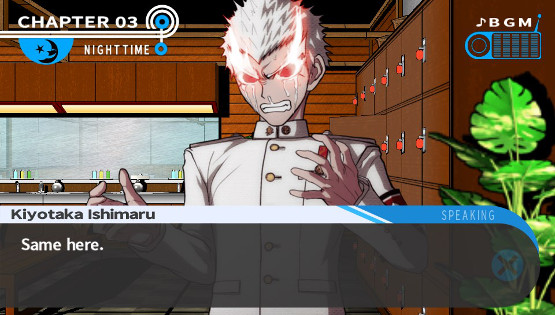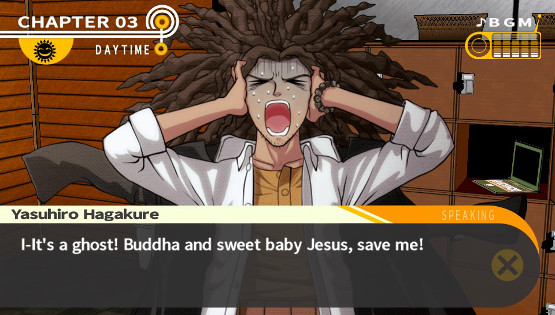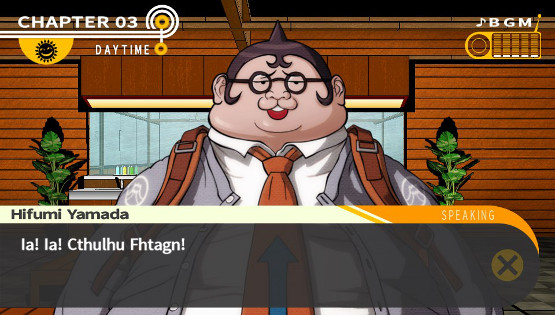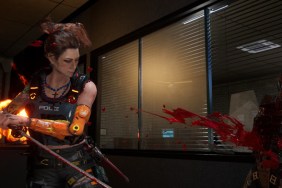Dangan Ronpa: Trigger Happy Havoc is a visual novel murder mystery with a diverse and obnoxious cast of characters locked away inside an idyllic school for prodigies. The only way to escape the school is to murder another student and get away with it. In order to get away with the murder, all of the remaining students must cross examine each other at the same time—among them the murderer, who can muck up the cross examination sequence. The set-up allows for bait and switch, betrayals, misleading info, and all of the other good stuff murder entails. And those obnoxious characters? They serve to make things more interesting.
Dangan Ronpa features 16 characters, including antagonist Monokuma; trapped within the walls of Hope’s Peak High School. The situation is similar to Agatha Christie’s And Then There Were None, as survivors blame each other amid the confusion following the murders. Players see the events through Makoto Naegi’s perspective and use his knowledge to suss out the clues and expose the villain or villains during each trial.
Not counting the prologue and epilogue, the game is divided into chapters with each trial providing the climax for each chapter. The beginning of each chapter will feature some free time before a murder takes place. During this time Makoto can explore all of the available portions of the school and spend some quality time with another schoolmate if he wishes. Spending time with others and giving them appropriate gifts won from the school’s gumball machine grants Makoto skills to use during the trials.
Exploration is done in first person mode. Dangan Ronpa was originally a PSP game, and as a result movement is primarily mapped to the right analog stick. Upon entering a room the first person view is stuck on a small rail. Players can move back forth enough to see behind objects and characters in the room. This works quite well, as most objects are 2D cutouts existing in a 3D space. Players can inspect points of interest within rooms, and during investigations use certain points of interest as “Truth Bullets”, or evidence. Once conditions are met players engage in Investigation mode, which functions just as above minus the ability to spend time with others.
After a certain amount of evidence has been collected players are called to the trial room and participate in discussion to determine the culprit. These trials are the most difficult part of the game due to the many different mini-games employed during the trials. Normally, players must find contradictions in statements and use their “Truth Bullets” to disprove statements within a time limit. The complexity of how to break statements escalates over the course of the game. There is also a hangman mini-game, a setup where players place comic panels, and a rhythm mini-game. The amount of difficulty one derives from the mini-games will be reduced by how much a player is able to block out during the more difficult sections. Dangan Ronpa will try to muck up your concentration with extra flash like the rotating camera as players enter discussion or the spinning background piece during most of the discussion. Other effects occur, and this is an excellent design choice for this game, since distraction is a player’s only true enemy.
Which brings up the next point—a lot of attention needs to be paid to the text on the screen and the available clues. Despite the Trigger Happy Havoc moniker, the most “Trigger Happy” the game gets is during the rhythm mini-games. There’s actually no benefit to spamming anything in the game, and doing so would reduce Makoto’s health to nothing during the trials very quick. In fact, the amount of precision necessary is only reinforced by the use of a bullet-time feature during trials to slow down the on-screen distractions for a proper shot.
The game’s logic puzzles are quite good. At the default setting, there is a nice combination of lead-in to clues while still maintaining difficulty. Players can select a two separate difficulty levels at the beginning for Action and Logic difficulties. Each difficulty has three settings, and for the purpose of this review the normal setting were used for both. If there is a complaint about the difficulty, the complaint lies in a trap to which a lot of murder mystery games succumb: a specific phrase or action the game wants. Sometimes, the player has to just use trial and error to find the proper response as opposed to using, say, a corresponding clue at one of several appropriate junctions. This is a little frustrating to those who have figured out the solution relatively early but have to use an arbitrary phrase to move things along. It crops up at least once per trial as well.
The overall plot is well done. While many unrealistic events happen, the scope of the matter within Hope’s Peak escalates fantastically and the game never lets up on new things to confuse the player. Even the denouement at the end of each chapter serves to escalate matters with new information.
Characterization is also very good. The cliché cast move beyond their initial personalities not by attaining new heights but by sinking to new lows. It is the cast’s obnoxiousness which will endear them to players as opposed to finding some hidden good within each character. It’s nice to see a cast of characters who make no effort in hiding the fact people will work towards their own ends. It’s not that the characters are deplorable; each character excels at one thing and as a result the rest of their lives are unbalanced. This is the setup for thousands of stories, but Dangan Ronpa is able to show that while people excel, it is often do to personal desire and can be at the expense of others. Yet the high points of humanity are still addressed, and Dangan Ronpa weaves both aspects of human nature very well.
The game does not hold back either. Some of the scenes are gruesome, the characters are often lost between repulsion and perversion, and the constant escalation of the game provides one the more entertaining detective stories I have played in a while. The situation is further helped along by how much fridge brilliance the game displays and how scenes and events work on a variety of levels. Players do not need to have a wide breadth of knowledge to enjoy Dangan Ronpa, but players will certainly enjoy it more. The best part about Dangan Ronpa is the game does not insult anyone’s intelligence.
The voicework is done very well for both Japanese and English. The game gives a choice at the start for the player’s preference. The trials have more voiceovers than other parts of the game. Sound effects are also well done and often homage a variety of sources. The graphics are fun to see, even if it’s 2D sprite cutouts on a 3D background. The portraits are of high quality and the other art-related bits are enjoyable.
The translation is good, but there were times jokes did not seem translated very well. The trials are almost fully voiced yet some lines feel out of place – most likely trying to place a joke for North American audiences, but failing an awkward check. However, there are parts where the translation shines, such as the myriad of homages in-game to other games, different anime series and manga, movies all around the world, and detective literature. Overall, the point of the game definitely gets across to its audiences, so the localization’s positives outshine any negatives.
The biggest problem faced in the game are the controls. The PSP controls are relatively simple, but the Vita controls complicate two things. Pressing the Vita face buttons often skipped dialogue twice so using the front touch screen for dialogue became the preferred navigation of choice. The other problem came in the form of the back touch screen. In trials, this can be used to remove overlapping discussions called white noise. What normally happened was the back touch screen would be accidentally bumped and the on-screen cursor was suddenly an entire screen over; or worse yet a penalty was suffered for hitting the wrong dialogue. This became problematic and old real quick during times when accuracy is key, so I advise players to watch their grip on their Vitas.
Beating the game unlocks another playable section called School Life. In this game, players mine the school for parts to create different Monokumas. The mechanic in the main game which allows players to spend time with other students is carried over to this part, and the skills learned here can be used in the main game. The coins earned in the game for the gumball machine can also be used to buy movies, music tracks, and promotional art. There’s also a secret ending. Replay value is pretty decent.
Overall, Dangan Ronpa: Trigger Happy Havoc is a great way to lose around 20 hours of time. It’s a great example of its genre. Dangan Ronpa is genuinely a entertaining ride and the plot advances at a great clip. Dangan Ronpa: Trigger Happy Havoc could use some more polishing, but fans of mystery or oddball characters will want to snatch this up.
-Review Copy Provided by Publisher
-
Plot advancement and characterization are great.
-
Game is suitably dark yet manages to be energetic.
-
An entertaining whodunit? Sign me up for round two.
-
Added Vita controls were not implemented very well.









